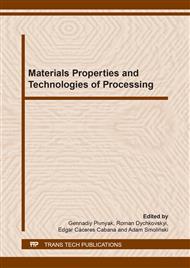[1]
Gapsari, F., Wahyudi, S., & Sumawan. (2014). The Influence of High Content of Silicon in Austenitic Stainless Steel to Corrosion Rate in Sulphuric Acid. Applied Mechanics and Materials, 493, 727-732. https://doi.org/10.4028/www.scientific.net/amm.493.727.
DOI: 10.4028/www.scientific.net/amm.493.727
Google Scholar
[2]
Gapsari, F., Andoko, Wijaya, H. (2018). Corrosion Behavior of Brass Acid, Metalurgija, 57, 333-336.
Google Scholar
[3]
Bashi, S.M., Mailah, N.F., & Radzi, M.A.M. (2003). Cathodic protection system. Proceed of the National Power & Energy Conference, 366-370.
DOI: 10.1109/pecon.2003.1437476
Google Scholar
[4]
Kim, I.-D., & Nho, E.-C. (2005). Module-Type Switching Rectifier for Cathodic Protection of Underground and Maritime Metallic Structures. IEEE Transactions on Industrial Electronics, 52(1), 181-189. https://doi.org/10.1109/tie.2004.841094.
DOI: 10.1109/tie.2004.841094
Google Scholar
[5]
Gapsari, F., Soenoko, R., Suprapto, A., & Suprapto, W. (2016). Green Inhibitor For Api 5L X65 Steel In HCl 0.5 M. ARPN Journal of Engineering and Applied Sciences, 11(15), 9524-9527.
Google Scholar
[6]
Gapsari, F., Soenoko, R., Suprapto, A., & Suprapto, W. (2016). Effect of Organics Corrosion Inhibitors on the Corrosion of 304SS in 3.5% NaCl. International Review of Mechanical Engineering (IREME), 10(7), 531. https://doi.org/10.15866/ireme.v10i7.9732.
DOI: 10.15866/ireme.v10i7.9732
Google Scholar
[7]
Gapsari, F., Soenoko, R., Suprapto, A., & Suprapto, W. (2015). Bee Wax Propolis Extract as Eco-Friendly Corrosion Inhibitors for 304SS in Sulfuric Acid. International Journal of Corrosion, 2015, 1-10. https://doi.org/10.1155/2015/567202.
DOI: 10.1155/2015/567202
Google Scholar
[8]
Suprapto, W., Soenoko, R., & Gapsari, F. (2018). Comparation of the analytical and experimental models of 304SS corrosion rate in 0.5 m H2SS4 with bee wax propolis extract. Engineering Review, 38(2), 182-188. https://doi.org/10.30765/er.38.2.6.
DOI: 10.30765/er.38.2.6
Google Scholar
[9]
Verma, A. R. B., & van Ooij, W. J. (1997). High-temperature batch hot-dip galvanizing. Part 1. General description of coatings formed at 560°C. Surface and Coatings Technology, 89(1-2), 132–142. https://doi.org/10.1016/s0257-8972(96)02941-6.
DOI: 10.1016/s0257-8972(96)02941-6
Google Scholar
[10]
Bondareva, O. (2014). Study of the Temperature Effect on the Structure and Thickness of Hot-Dip Zinc Coatings on Fixing Products. Applied Mechanics and Materials, 698, 355-359. https://doi.org/10.4028/www.scientific.net/amm.698.355.
DOI: 10.4028/www.scientific.net/amm.698.355
Google Scholar
[11]
Pokorny, P., Kolisko, J., Balik, L., & Novak, P. (2016). Effect of chemical composition of steel on the structure of hot – Dip galvanized coating. Metalurgija, 55, 115.
Google Scholar
[12]
Liberski, P. (2013). Anticorrosive Hot-Dip Galvanized Coatings, Politech. Śl.
Google Scholar
[13]
Bakhtiari, A. (2014). The relationship between surface treatments and corrosion resistance of hot-dip galvanized steel. Metallurgical and Materials Engineering, 20(3), 165-170. https://doi.org/10.5937/metmateng1403165b.
DOI: 10.5937/metmateng1403165b
Google Scholar
[14]
Diaconu, A., Solomom, C., Benea, L., Dumitraşcu, V., & Mardare, L. (2013). Corrosion Resistance Of Zinc Coated Steel In Sea Water Environmen. The Annals of Dunarea de Jos,, 3, 201.
Google Scholar
[15]
Kania, H. (2012). The structure of coatings obtained in the Zn-31Al-3Mg bath by the batch hot dip method. IOP Conference Series: Materials Science and Engineering, 35, 012003. https://doi.org/10.1088/1757-899x/35/1/012003.
DOI: 10.1088/1757-899x/35/1/012003
Google Scholar
[16]
Proskurkin, E.V., Popovich, V.A., & Moroz, A.T., (1988). Hot-dip galvanizing. Handbook. 1st ed. Metallurgy. Moscow, (1988).
Google Scholar
[17]
Burton, B.P., & Perrot, P. (1992). ASM Metals-Handbook, Alloy phase diagrams, 3.
Google Scholar
[18]
Popov, B.N. (2015). Corrosion Engineering. Elsevier, California.
Google Scholar
[19]
Kania, H. (2012). The structure of coatings obtained in the Zn-31Al-3Mg bath by the batch hot dip method. IOP Conference Series: Materials Science and Engineering, 35, 012003. https://doi.org/10.1088/1757-899x/35/1/012003.
DOI: 10.1088/1757-899x/35/1/012003
Google Scholar
[20]
Li, Y. (2001). Corrosion behaviour of hot dip zinc and zinc-aluminium coatings on steel in seawater. Bulletin of Materials Science, 24(4), 355–360. https://doi.org/10.1007/bf02708631.
DOI: 10.1007/bf02708631
Google Scholar
[21]
Deshmukh, B.D., & Patil, A.P. (2012). Optimization of exposure time for hot dip galvanizing and study the effects of preflux bath additives on the microstructures of galvanized steel. The International Journal of Emerging Technology and Advanced Engineering, 2, 71-75.
Google Scholar
[22]
Lim, C.Y., Lee, F.T., & Lim, Y.Y. (2007). Corrosion Investigation of coatings on mild Steel substrate exposed to various corrosive environments, Malaysian Journal of Chemistry, 9, 040050.
Google Scholar
[23]
Koszegi, S. (2001). Effect of different galvanized coatings on the materials structure of conversion layers. Budapest University of Technology and Economics.
Google Scholar


